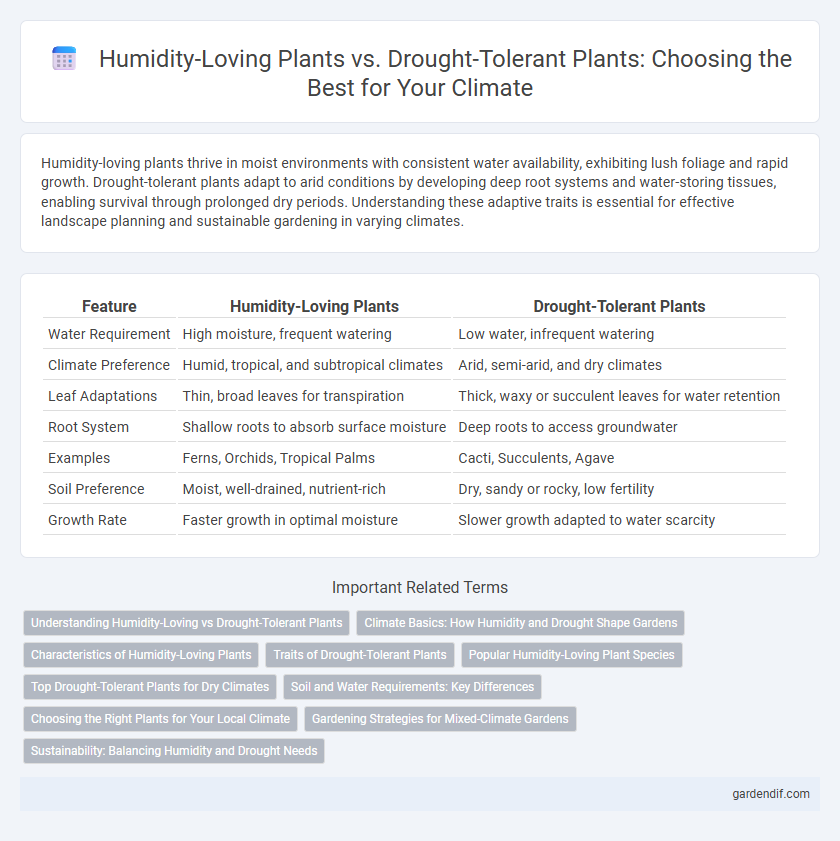
Humidity-loving plants vs drought-tolerant plants Illustration
Humidity-loving plants thrive in moist environments with consistent water availability, exhibiting lush foliage and rapid growth. Drought-tolerant plants adapt to arid conditions by developing deep root systems and water-storing tissues, enabling survival through prolonged dry periods. Understanding these adaptive traits is essential for effective landscape planning and sustainable gardening in varying climates.
Table of Comparison
| Feature | Humidity-Loving Plants | Drought-Tolerant Plants |
|---|---|---|
| Water Requirement | High moisture, frequent watering | Low water, infrequent watering |
| Climate Preference | Humid, tropical, and subtropical climates | Arid, semi-arid, and dry climates |
| Leaf Adaptations | Thin, broad leaves for transpiration | Thick, waxy or succulent leaves for water retention |
| Root System | Shallow roots to absorb surface moisture | Deep roots to access groundwater |
| Examples | Ferns, Orchids, Tropical Palms | Cacti, Succulents, Agave |
| Soil Preference | Moist, well-drained, nutrient-rich | Dry, sandy or rocky, low fertility |
| Growth Rate | Faster growth in optimal moisture | Slower growth adapted to water scarcity |
Understanding Humidity-Loving vs Drought-Tolerant Plants
Humidity-loving plants thrive in environments with consistent moisture, displaying adaptations such as broad leaves and stomata that facilitate efficient water absorption and retention. Drought-tolerant plants possess features like deep root systems, reduced leaf surface area, and waxy coatings to minimize water loss and survive prolonged dry periods. Understanding these physiological differences aids in selecting suitable vegetation for varied climatic conditions, optimizing growth and conservation efforts.
Climate Basics: How Humidity and Drought Shape Gardens
Humidity-loving plants thrive in consistently moist environments with relative humidity levels above 60%, relying on steady water availability for optimal growth. Drought-tolerant plants adapt to arid climates by developing deep root systems and water-storing tissues, allowing survival during prolonged dry periods with less than 30% relative humidity. Understanding these climatic requirements is crucial for sustainable garden design, as matching plant species to local humidity and drought conditions reduces water usage and supports ecosystem resilience.
Characteristics of Humidity-Loving Plants
Humidity-loving plants thrive in environments with consistently high moisture levels, often exhibiting broad, thin leaves that maximize transpiration and nutrient absorption. These plants typically possess specialized stomata that remain open longer, facilitating efficient gas exchange in humid conditions. Adaptations such as shallow root systems and waxy leaf surfaces help maintain hydration and prevent fungal infections common in damp habitats.
Traits of Drought-Tolerant Plants
Drought-tolerant plants possess deep root systems that efficiently access underground water reserves and exhibit thick, waxy leaves to reduce water loss through evaporation. These plants often have small or needle-like leaves with stomata that close during the hottest parts of the day to conserve moisture. Adaptations like water storage tissues and the ability to enter dormancy during extended dry periods enable them to survive and thrive in arid environments.
Popular Humidity-Loving Plant Species
Popular humidity-loving plant species such as ferns, peace lilies, and philodendrons thrive in environments with high moisture levels, making them ideal for tropical and subtropical climates. These plants require consistent humidity above 50% to maintain vibrant foliage and prevent leaf drop. Unlike drought-tolerant plants that store water in their leaves or stems, humidity-loving species absorb moisture directly from the air, necessitating frequent misting or humidifier use in dry indoor settings.
Top Drought-Tolerant Plants for Dry Climates
Top drought-tolerant plants for dry climates include succulents such as agave and aloe vera, which store water in their leaves, allowing them to survive prolonged dry spells. Native species like lavender and sage thrive with minimal watering due to their deep root systems and natural adaptations to arid environments. These plants reduce water usage while enhancing landscape resilience in regions prone to drought and high temperatures.
Soil and Water Requirements: Key Differences
Humidity-loving plants thrive in moist, well-drained soils with consistent watering to maintain high soil moisture levels, essential for their growth and nutrient uptake. In contrast, drought-tolerant plants are adapted to arid environments with sandy or rocky soils that drain quickly, requiring minimal water and demonstrating efficient water retention mechanisms. Understanding these soil and water requirements is crucial for selecting appropriate plant species for varying climate conditions and ensuring sustainable landscaping practices.
Choosing the Right Plants for Your Local Climate
Humidity-loving plants such as ferns and orchids thrive in environments with consistent moisture and high relative humidity, making them ideal for tropical or subtropical climates. Drought-tolerant plants like succulents, cacti, and lavender adapt to arid conditions by storing water efficiently and reducing transpiration, suitable for dry, desert, or Mediterranean climates. Selecting the right plants based on local climate ensures optimal growth, reduces water usage, and promotes sustainable landscaping.
Gardening Strategies for Mixed-Climate Gardens
Humidity-loving plants such as ferns, calatheas, and peace lilies thrive in moist, shaded environments, requiring consistent watering and high humidity levels to maintain lush foliage. Drought-tolerant plants like succulents, lavender, and agave adapt to arid conditions by storing water in their leaves and minimizing transpiration, making them ideal for sunny, dry spots. Effective gardening strategies for mixed-climate gardens include zoning plants based on their moisture needs, using mulch to retain soil moisture around humidity-loving varieties, and selecting drought-resistant species for exposed, less irrigated areas.
Sustainability: Balancing Humidity and Drought Needs
Humidity-loving plants, such as ferns and mosses, thrive in consistently moist environments, contributing to enhanced air quality and soil stability by maintaining higher humidity levels. Drought-tolerant plants, including succulents and cacti, conserve water through specialized adaptations like thick cuticles and deep root systems, reducing irrigation needs and promoting water conservation in arid regions. Balancing the cultivation of both plant types supports sustainable landscaping by optimizing water usage and preserving ecosystem resilience amid changing climate conditions.
Humidity-loving plants vs drought-tolerant plants Infographic

 gardendif.com
gardendif.com